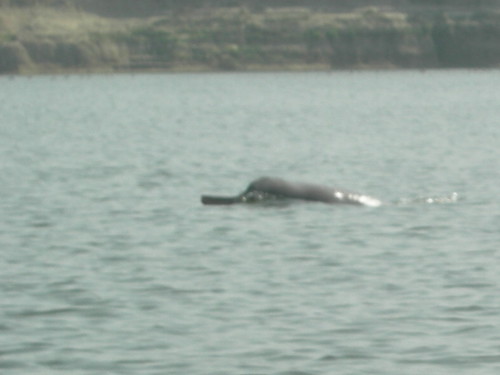Ganges River Dolphin (known as Soons by locals in India shushuk in Bangladesh) is a subspecies of river dolphins mainly found in Bangladesh, India and Nepal. A similar subspecies the Indus River Dolphin is found in Pakistan. These are found in the Ganges and Brahmaputra Rivers and their tributaries and the Indus River and its tributaries Beas River and Sutlej River. The Ganges river dolphin is recognized by the government of India as its National Aquatic Animal.
These river dolphins have long pointed noses like all river dolphins with their teeth visible in the upper and lower jaws even when the mouth is closed. Adult female dolphins are larger than male dolphins. The species feeds on a variety of shrimp and fish including carp and catfish.
These river dolphins have been adversely affected by the use of the river systems by humans in by polluting them intolerably. Pollution by fertilizers, pesticides and industrial and domestic effluents are responsible for the death of many fishes and dolphin populations. Though they are protected species, they are caught by fishermen and their oil and meat are used as a liniment, as an aphrodisiac and as bait for fishing. Both the subspecies are listed by the IUCN as endangered on the Red List of Threatened Species.
The Vikramshila Gangetic Dolphin Sanctuary in Bhagalpur District of Bihar, India, a 50 km stretch of Ganges River from Sultanganj to Kahalgaon, is the only protected area for the Gangetic dolphins. Now only few hundreds of the river dolphins are remaining and half of Gangetic dolphins found here.
Classified as “endangered” in the 2006 IUCN Red List of Threatened Species & included Schedule-I of the Indian Wildlife Protection Act, 1972, they are among the oldest creatures in the world along with crocodiles, sharks and some turtles.
The Buriganga in Bangladesh, Dhaka's lifeline from times immemorial and where Gangetic dolphins were abundant in the past, is now threatened by pollution and encroachment, with about 80% of Dhaka's sewage flowing into the river untreated. The flow of water in the Buriganga is very low except during the monsoon season, when it is flooded. Here when the water quality is not at its worst, river dolphins can still be sighted.

No comments:
Post a Comment